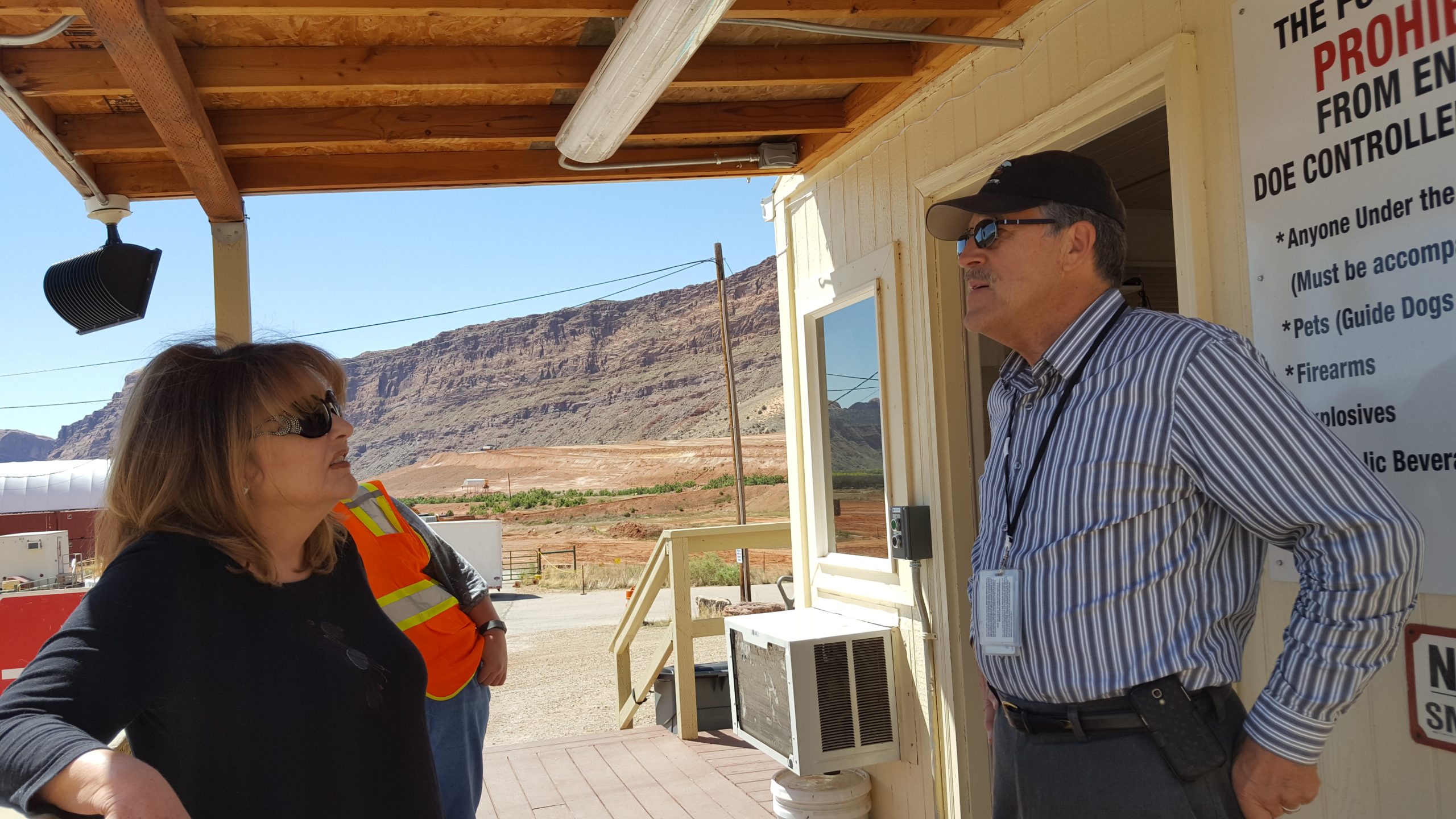Some information may be outdated.
Anxiety and frustration are mounting for the 112 employees at the Moab Uranium Mill Tailings Remedial Action (UMTRA) Project, where they will learn on Tuesday, April 26, who among them face immediate and indefinite layoffs.
Employees were notified on April 6 that 30 to 35 positions face an impending “involuntary separation,” when U.S. Department of Energy (DOE) officials announced that the project’s focus would shift to expanding the long-term disposal site at Crescent Junction, about 30 miles north of Moab.
Employees don’t currently know who will be separated, and they will be notified in writing when they report to work on the morning of April 26.
“There are a lot of depressed people here,” said one employee who asked not to be identified. “People with families, houses and debt are now facing the prospect of having to move and find work.”
According to contracted S&K Aerospace Public Relations Manager Wendee Ryan, the shift in priorities necessitated a reduction in shipments of the hazardous material to the disposal site. Additionally, project resources have had to be diverted to repair shipping containers due to corrosion from the tailings materials, and to repair or replace aging heavy equipment, she said.
“The Remedial Action Contractor (Portage Inc.) considered options to accomplish the work and chose to reduce tailings shipments from four per week, to two per week to allow year round operations to continue.” Ryan said. “With this reduction in shipments, there will be a reduction in staff.”
Ryan said that the contract awarded to Portage Inc. allowed for a three month-plus curtailment in shipments. In most years, she said, the UMTRA Project received enough funding to avoid it. However, in 2016, it was realized that another curtailment would be necessary to handle other emerging requirements, such as equipment maintenance and replacement, upgrades to aging infrastructure, and cell excavation at the disposal site.
“In light of these needs, the contractor, with DOE approval, determined the best option would be to reduce the shipping schedule in May to avoid a much longer curtailment next year in addition to the curtailment this summer,” Ryan said.
But another employee who asked to remain anonymous said that he believes that Portage wasted money on a shade structure, and the remodeling of an Atlas Minerals-era building that will eventually be torn down. In addition, he said that money spent to mitigate rockfall damage after a slide hit the project’s loading facility in November 2014, was “overkill.”
Ryan said that the DOE places itsthe highest priority on the safety and protection of the workers, public and the environment. That priority is at the forefront of every task that’s implemented or performed at the site, she said.
Subject to the whims of annual federal budget appropriations, the Moab UMTRA Project has run into funding setbacks multiple times since cleanup work began almost seven years ago. With an infusion of federal stimulus money in 2010 and 2011, the project gained momentum, but in ensuing years, funding cuts and acts of nature have interrupted progress at the cleanup site.
In February, the DOE’s national office announced that it is seeking a “modest” $3.8 million in budget cuts from UMTRA for the 2017 fiscal year, only weeks after committing its continued support for the project.
The DOE’s Office of Environmental Management said that its proposed reduction is needed to align its priorities throughout the Moab UMTRA cleanup complex, which includes the long-term disposal cell near Crescent Junction.
“The decrease reflects (a) shift in activities from transportation of tailings to excavation of disposal cell capacity,” the agency said in its budget justification to Congress.
In response, the Grand County Council and Moab Mayor Dave Sakrison, sent a letter to Utah’s congressional delegation to intervene for a reallocation of project funding, which topped $38 million this year. The letter expressed concern over possible layoffs and outlined health and safety concerns associated with project delays.
Grand County Council member Mary McGann said she was praying that the letter would make a difference.
“Then we got the notice that money was being re-directed,” McGann said. “We’re really upset by this.”
Grand County UMTRA Liaison Lee Shenton said that the DOE’s Office of Environmental Management warned community leaders as far back as 2012 that periodic slowdowns were possible, and that the project suspended shipments for three months that winter.
Shenton said it is important to realize that this was the result of shifting priorities within the DOE, and that it wasn’t the result of anything UMTRA did or didn’t do.
“While difficult for Moab and DOE’s other small remediation projects around the country, DOE has chosen to use more of their limited funding for remediation of sites with more hazardous materials, such as the Hanford site in southeast Washington state,” Shenton said. “For me, it is difficult to argue with that choice.”
Shenton said that the decrease in funding would likely push completion of the project back eight to 10 years.
When funding was first appropriated in 2005, the project had an estimated completion date of 2019. The most recent estimate, prior to the setback in funding, was 2025.
The uranium mill tailings pile covers about 130 acres of the 480-acre site near the banks of the Colorado River. It’s the legacy of a Cold War-era facility that processed radioactive and heavy metal-laden uranium ore from numerous mines dotted across the region.
Rail shipments of tailings, and other potentially hazardous material to the disposal cell at Crescent Junction, began in April 2009. In December 2015, the project reached its halfway mark by removing some 8 million tons of material from the pile.
The recent layoffs and loss of funding are seen as a major setback to the community.
“We’re a small town,” McGann said. “People will lose jobs. And the longer we wait to move that pile, the more likely it is to flood.”
Shenton said that UMTRA employees are highly skilled, and that their skills are portable, but unfortunately, many of them will need to relocate to find work.
“That will be difficult for the employees and their families, and those are a lot of good-paying jobs to be lost in a community the size of Moab,” he said.
30-35 employees still in the dark about who will be laid off on April 26
We’re a small town … People will lose jobs. And the longer we wait to move that pile, the more likely it is to flood.
Appreciate the coverage? Help keep local news alive.
Chip in to support the Moab Sun News.





